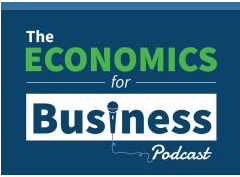What drives customer behavior and customer choices? It’s the existential question for business; you’ve got to know the answer. But it’s a mystery, hard to unlock. The solution to this answer lies in what market researchers call insights, based on the Austrian deductive method that we summarized in episode #164 with Per Bylund (Mises.org/E4B_164). In episode #165, we talk to Darshan Mehta, a lifelong professional in the field, an advisor to global and local brands, an originator of insights technology, and a deep thinker in the field. Key Takeaways and Actionable Insights Insights mark the road to innovation and differentiation and give businesses a competitive advantage. By definition, an insight is a deep understanding of the motivation of an individual: why
Topics:
Hunter Hastings considers the following as important: 6b) Mises.org, Featured, newsletter
This could be interesting, too:
Nachrichten Ticker - www.finanzen.ch writes Die Performance der Kryptowährungen in KW 9: Das hat sich bei Bitcoin, Ether & Co. getan
Nachrichten Ticker - www.finanzen.ch writes Wer verbirgt sich hinter der Ethereum-Technologie?
Martin Hartmann writes Eine Analyse nach den Lehren von Milton Friedman
Marc Chandler writes March 2025 Monthly
What drives customer behavior and customer choices? It’s the existential question for business; you’ve got to know the answer. But it’s a mystery, hard to unlock. The solution to this answer lies in what market researchers call insights, based on the Austrian deductive method that we summarized in episode #164 with Per Bylund (Mises.org/E4B_164). In episode #165, we talk to Darshan Mehta, a lifelong professional in the field, an advisor to global and local brands, an originator of insights technology, and a deep thinker in the field.
Key Takeaways and Actionable Insights
Insights mark the road to innovation and differentiation and give businesses a competitive advantage.
By definition, an insight is a deep understanding of the motivation of an individual: why they do what they do, choose what they choose, and stop doing what they used to do? What guides their behaviors, what they do with their time, and how they find betterment and ease?
These individual motivations can sometimes be exhibited as technology trends, social trends and cultural shifts. Insights help businesses understand the drivers of these shifts in the landscape, as well as how these shifts, in turn, change individual behavior. Causality works in both directions.
Insights are multi-dimensional, and businesses need to install multi-dimensional systems to generate insights.
No single method and no single information or data source will deliver the deep and rich insights businesses need. Darshan Mehta recommends a multi-dimensional approach.
Conversations with customers
This is the number one source of data for insights generation: deep, rich, personal, subjective, and revealing. It requires some skill development to be good at customer conversations. Empathy is a key ingredient — what Darshan calls “being a people person”, interested in how people feel, and with the curiosity to learn and the humility to understand that a lot of what is important to customer decision-making resides in the sub-conscious and is difficult to articulate. In fact, conversation helps people to learn how to describe their feelings and motivations, if the interviewer lets the conversation develop slowly and with time for self-reflection to dawn. The human-to-human connection factor is important, whether in a one-on-one conversation, a group setting (such as a focus group) or an online chat.
Whether your business is present in the conversation or not, customers are having those conversations, so it’s important to listen and take part.
There are tools on the econ4business.com website to frame in-depth interviews:
- Contextual In-Depth Interview Method: Mises.org/E4B_165_Contextual
and for listening with empathy:
- Episode 33 “Isabel Aneyba: Listening From the Heart and the Techniques of Empathy”: Mises.org/E4E_33
Behavior observation
The Austrian deductive method comes into play when the data is in the form of behavior that we can actually observe — accompanied shopping, ethnography, buying data, shopping data, video data, eye-tracking, A/B testing. All of these give us information about behavior. The next step in insight generation is to deduce the drivers of the behavior. Sometimes we may have some conversational data or sentiment data (such as from surveys) to combine with the behavioral data, sometimes not.
The process of working backwards from behavior to motivation uses the question, “Why?” Why did they act that way? Why did they reject an alternative? What could possibly be behind the behavior? If they acted unexpectedly, or out-of-pattern, or differently than last time, why was that? The standard of 5 Why’s is often invoked to get to the deepest understanding. But it’s not the repetitive 5 Why’s of the child asking mom why they can’t have a piece of candy. The Why’s must be deeply thought-out, probing, significant Why’s to get to the next level of understanding.
Data analytics
Analysis of so-called big data can make a contribution to multi-dimensional insights generation, especially if the data relates to behavior such as buying patterns, clickstreams, and cultural shifts in behavior (like Tik-Tok usage). Data can’t reveal drivers or deeply felt dissatisfactions, but it can reveal trends and even suggest some preferences (e.g., shifts in usage from one brand of social media to another). Data analysis algorithms don’t ask why, they ask what — especially what data patterns and pattern shifts can be observed. Bear this in mind when integrating data analytics into your multi-dimensional insights generation process.
Learn the language of dissatisfaction.
The drivers of customer choice are always derived from dissatisfaction. Because they are seeking betterment, they must, logically, be dissatisfied with current conditions. It’s very tricky to identify dissatisfactions because the language of articulation is subjective and personal. Researchers and engineers and designers talk about “pain points”, but customers probably don’t. They may talk about what makes them “crazy”, or “upset”, or “frustrated”. Relative satisfaction / dissatisfaction could be revealed by brand-switching. Installing feedback loops for activation immediately after the customer’s product or service experience can help gather relevant data, especially if you can gather the feedback in the customer’s language rather than your own.
Insights are built through combination, recombination, and synthesis.
“Insights lie where worlds collide” is a quote from Darshan’s book (Getting To Aha! Why Today’s Insight Are Tomorrow’s Facts). What he means by that is it’s a combination and recombination of conversational data and analytical data and trend observations and cultural shifts that ultimately generate the insight.
Blending and mixing and putting elements together to reveal new possibilities beats logic in the process of insights generation. Call it synthesis. And before synthesis can take place, the ability to break down wholes into component parts in a creative way is required. Analysis and synthesis, destruction and creation.
Ultimately, human emotion lies behind all insights and all innovation: experiences are feelings.
Technically, the drivers of customer behavior change can be tracked to functional factors such as speed (faster), cost (cheaper), and / or convenience (easier). But beyond these lies emotion — the feeling that an experience is, was, or can be great. Customers buy experiences, not goods or services. A solution that evokes emotion results in (according to Darshan) a response that’s 12X stronger than one based on just faster/cheaper/easier. Therefore, an insight that evinces emotion — reveals it, brings it to light — is the most valuable of all.
It’s important to understand the language of positive emotion, as well as the language of dissatisfaction. An experience evokes emotion when customers call it amazing or super-cool or use superlatives of that kind.
Customers bond most strongly to businesses that can align with their highest values.
Beyond even the strongest emotional benefits lie highest values: lifetime values for which customers are always striving. Examples include family security — always a goal and never entirely realized — a sense of achievement — there’s always more to achieve — and a world of peace — we know today how elusive that is.
Brands that can associate themselves with these highest values — purpose-driven brands — or help customers attain them for themselves will be especially prized and loved in today’s markets. Humanizing brands in a digital world is a difficult standard to attain, and making the emotional connection with the customer on the subject of their highest and most strongly held values is the pathway.
Listen to the Economics For Business Podcast (Mises.org/E4BPod) on the role of highest values in business.
It’s a modern expression of customer sovereignty that brand buyers are so active in evaluating products and services based on their assessment of the values exhibited by the corporations behind them, and that they seek to change the world through buying and not buying.
Better insights can help led us to a better world by identifying dissatisfactions and pointing to new solutions. Insights are visions of what makes us human, improving what connects us and unites us.
Additional Resources
Getting To Aha! Why Today’s Insights Are Tomorrow’s Facts by Darshan Mehta: Mises.org/E4B_165_Book
Tags: Featured,newsletter









